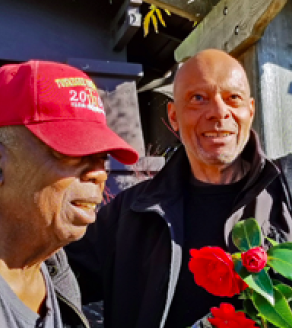Sociology@UCSantaCruz Professor Emeritus John Brown Childs reflected the following in a recent article posted in the UC Santa Cruz Emeriti Association Newsletter.
“...what is American society? Is it the kind of society… that permits people to grow and develop… that gives them a sense of value, not only for themselves, but… for other human beings?”
—Ella Baker, co-founder of the Student Non-Violent Coordinating Committee, 1969
It was a pleasure talking with Mr. Drew Glover, a young African-American activist at the “Resource Center for Non-Violence” in Santa Cruz, as part of the KZSC podcast, “From Santa Cruz to Selma,” hosted by Santiago álvarez. That title, “From Santa Cruz to Selma,” refers to Drew's innovative program of bringing young people from Santa Cruz to Selma, Alabama, so they can connect to historic and contemporary activism there.
My own core project is the development of the concept I call “transcommunality.” Transcommunality involves ways for people to maintain rooted affiliations, while simultaneously creating constellations of cooperation drawing from, rather than obliterating, diversity. In this work I draw from many sources. The most important one is the Haudenosaunee (Iroquois) “Great League of Peace.” Their protocols for coordinated respectful autonomy and cooperation among different communities remain vividly useful today.
Previously, in 1963, I worked as a volunteer at the University of Massachusetts, Amherst, helping to organize a local contingent headed for the “March on Washington for Jobs and Freedom.” At that gathering, Rev. King was of course inspiring. But I was especially struck by the dynamic action-driven words of John Lewis from the Student Non-Violent Coordinating Committee. Lewis emphasized economic inequality as a major corrosive element undermining human rights in the United States. He proclaimed that the “black masses are on the march” in the “revolution.”
The “March on Washington” was the centerpiece of 1963 grassroots mobilization success, but on either side of that moment erupted horrible acts of segregationist violence. Only a few months earlier, Medgar Evers, Field Secretary of the NAACP, was shot in the back and killed in front of his home in Jackson, Mississippi. Less than four weeks after the March on Washington, four African-American children in Sunday school were killed when pro-segregationists bombed the Sixteenth Street Baptist Church in Birmingham, Alabama.
In 1965, as a member of the group, “Friends of SNCC”--the support group for the Student Non-Violent Coordinating Committee, I responded to their call to go to Montgomery, Alabama, to aid in their voting rights campaign. SNCC was a pivotal civil rights organization of the 1960's, imbued with an emphasis on grassroots organizing. My friend, Alabama-born Hardy T. Frye (also a UCSC Emeritus Professor of Sociology), was at that time a SNCC field worker in rural areas of that state, where black churches were being burned by segregationist forces.
I turn to my own ancestors, whose pathways I continue to follow. My mother, Dorothy (Burr) Pettijohn's, Indigenous ancestors, the “Massachuset-Ponkapoag / Big Hills, Sweet Water people” joined with other Native refugees in 1774, on land offered by the Oneida Nation, to create a community, in upstate New York, with their own farms and schools untrammeled by colonizers. This town was called “Brothertown” or, in their Algonkian language, “Eyamwauconnauck--the place of equal people.” As a young woman, my mother taught in a Congregational Church school in Alabama where she married my father, John Brown Childs. The Childs family in Marion, Alabama, were one of seven Black families who created a unique and influential school immediately after the Civil War, called “Lincoln Normal,” for African-Americans who aspired to be teachers.For the past twelve years, I have been teaching courses on “transcommunality” in Soledad State Prison as part of the community organization Barrios Unidos' “Prison Project.” BU was founded by UCSC alumnus Daniel Nane Alejándrez. Some of my multi-ethnic Soledad students recently created their own highly successful transcommunality class. The students have become the teachers.
Today we are confronted by voices and actions inflaming our nation with emotionalism, fear, and hatred. By contrast, positive actions such as those of the Soledad men and of young activists like Drew Glover, are sustaining past achievements by building transcommunal bridges of the human spirit across which respectful, rational, and compassionate community is being created. Ella Baker would, I believe, be proud of them.

